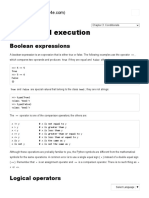4.control Work Flow Python
Uploaded by
Faisal Saeed Saeed4.control Work Flow Python
Uploaded by
Faisal Saeed SaeedPython Documentation For This Video
Boolean Operators
The not Operation
Sometimes we want to know the opposite boolean value for something. This might not sound
intuitive, but sometimes we want to execute an if statement when a value is False, but that’s
not how the if statement works. Here’s an example of how we can use not to make this work:
>>> name = ""
>>> not name
True
>>> if not name:
... print("No name given")
...
>>>
We know that an empty string is a “falsy” value, so not "" will always return True. not will
return the opposite boolean value for whatever it’s operating on.
The or Operation
Occasionally, we want to carry out a branch in our logic if one condition OR the other condition
is True. Here is where we’ll use the or operation. Let’s see or in action with an if statement:
>>> first = ""
>>> last = "Thompson"
>>> if first or last:
... print("The user has a first or last name")
...
The user has a first or last name
>>>
If both first and last were “falsy” then the print would never happen:
>>> first = ""
>>> last = ""
>>> if first or last:
... print("The user has a first or last name")
...
>>>
Another feature of or that we should know is that we can use it to set default values for
variables:
>>> last = ""
>>> last_name = last or "Doe"
>>> last_name
'Doe'
>>>
The or operation will return the first value that is “truthy” or the last value in the chain:
>>> 0 or 1
1
>>> 1 or 2
1
The and Operation
The opposite of or is the and operation, which requires both conditions to be True. Continuing
with our first and last name example, let’s conditionally print based on what we know:
>>> first = "Keith"
>>> last = ""
>>> if first and last:
... print(f"Full name: {first} {last}")
... elif first:
... print(f"First name: {first}")
... elif last:
... print(f"Last name: {last}")
...
First name: Keith
>>>
Now let’s try the same thing with both first and last:
>>> first = "Keith"
>>> last = "Thompson"
>>> if first and last:
... print(f"Full name: {first} {last}")
... elif first:
... print(f"First name: {first}")
... elif last:
... print(f"Last name: {last}")
...
Full name: Keith Thompson
>>>
The and operation will return the first value that is “falsy” or the last value in the chain:
>>> 0 and 1
0
>>> 1 and 2
2
>>> (1 == 1) and print("Something")
Something
>>> (1 == 2) and print("Something")
False
You might also like
- Computing: Introduction To Python: Lesson SixNo ratings yetComputing: Introduction To Python: Lesson Six28 pages
- Learn Python 3 - Control Flow Cheatsheet - CodecademyNo ratings yetLearn Python 3 - Control Flow Cheatsheet - Codecademy5 pages
- Learn Python 3 - Python - Code ChallengesNo ratings yetLearn Python 3 - Python - Code Challenges7 pages
- Learn Python 3 - Control Flow Cheatsheet - CodecademyNo ratings yetLearn Python 3 - Control Flow Cheatsheet - Codecademy5 pages
- Learn Python 3 - Control Flow Cheatsheet - CodecademyNo ratings yetLearn Python 3 - Control Flow Cheatsheet - Codecademy5 pages
- CTP - Introduction To Python Basics - Lect005No ratings yetCTP - Introduction To Python Basics - Lect00524 pages
- Python Fundamentals For Data Science (Part I) - Python Control Flow Cheatsheet - CodecademyNo ratings yetPython Fundamentals For Data Science (Part I) - Python Control Flow Cheatsheet - Codecademy4 pages
- Learn Python 3 - Control Flow Cheatsheet - CodecademyNo ratings yetLearn Python 3 - Control Flow Cheatsheet - Codecademy4 pages
- Learn Python 3 - Python - Code Challenges (Optional) Cheatsheet - Codecademy100% (1)Learn Python 3 - Python - Code Challenges (Optional) Cheatsheet - Codecademy7 pages
- Learn Python 3_ Control Flow Cheatsheet _ CodecademyNo ratings yetLearn Python 3_ Control Flow Cheatsheet _ Codecademy4 pages
- Python Basics - Python Syntax: Whitespace and IndentationNo ratings yetPython Basics - Python Syntax: Whitespace and Indentation18 pages
- Learn Python 3 - Python - Code Challenges (Optional) Cheatsheet - CodecademyNo ratings yetLearn Python 3 - Python - Code Challenges (Optional) Cheatsheet - Codecademy12 pages
- Ch No 2 Python Operator & Control Flow-1No ratings yetCh No 2 Python Operator & Control Flow-1103 pages
- Spam Spam: Python Basics Math Operators Highest Lowest Data Types Data Type ExamplesNo ratings yetSpam Spam: Python Basics Math Operators Highest Lowest Data Types Data Type Examples42 pages
- Chapter - 1 of Computer Science Class 12No ratings yetChapter - 1 of Computer Science Class 1215 pages
- Starting Off: Expressions and StatementsNo ratings yetStarting Off: Expressions and Statements7 pages
- Learn Python 3 - Control Flow Cheatsheet - CodecademyNo ratings yetLearn Python 3 - Control Flow Cheatsheet - Codecademy5 pages
- Learn Python 3_ Control Flow Cheatsheet _ CodecademyNo ratings yetLearn Python 3_ Control Flow Cheatsheet _ Codecademy5 pages
- Python Control Flow Cheatsheet KDnuggetsNo ratings yetPython Control Flow Cheatsheet KDnuggets1 page
- Python Control Flow Cheatsheet KDnuggetsNo ratings yetPython Control Flow Cheatsheet KDnuggets1 page
- Conditional Execution: Boolean ExpressionsNo ratings yetConditional Execution: Boolean Expressions12 pages
- Python Operators - Arithmetic, Logical, Comparison, Assignment, Bitwise & PrecedenceNo ratings yetPython Operators - Arithmetic, Logical, Comparison, Assignment, Bitwise & Precedence11 pages
- Strings (The Type) : Python Documentation For This VideoNo ratings yetStrings (The Type) : Python Documentation For This Video2 pages
- Asterisk Advanced Lab Assignment: Building A Basic PBX Extensions SIP Phones Configuration FilesNo ratings yetAsterisk Advanced Lab Assignment: Building A Basic PBX Extensions SIP Phones Configuration Files10 pages
- LinuxCBT Moni-Zab Edition Classroom NotesNo ratings yetLinuxCBT Moni-Zab Edition Classroom Notes5 pages








































































